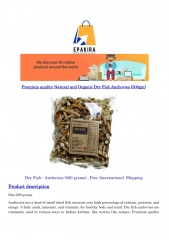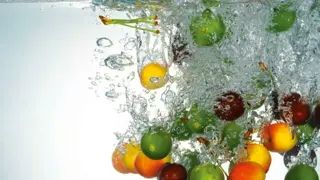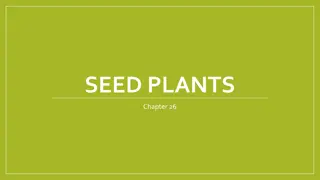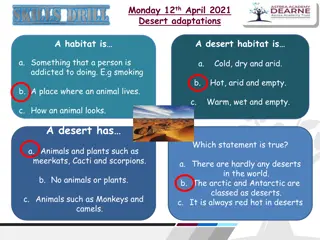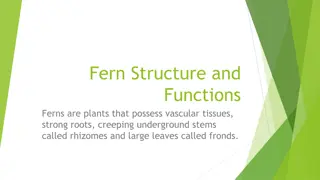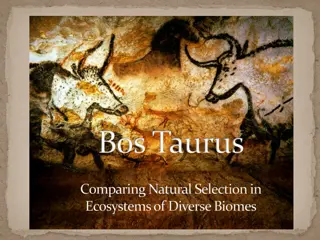Xerophytes: Adaptations to Thrive in Dry Environments
Xerophytes are plants that adapt to dry habitats by developing specialized structural and physiological features. These adaptations include deep root systems, succulent tissues for water storage, reduced leaf size with protective waxy coatings, and shortened life cycles for favorable conditions. Morphological adaptations involve unique root structures, stunted woody stems, and reduced or modified leaves. Anatomical adaptations include well-developed root hairs, water storage tissues, and specialized leaf structures to minimize water loss.
Download Presentation

Please find below an Image/Link to download the presentation.
The content on the website is provided AS IS for your information and personal use only. It may not be sold, licensed, or shared on other websites without obtaining consent from the author.If you encounter any issues during the download, it is possible that the publisher has removed the file from their server.
You are allowed to download the files provided on this website for personal or commercial use, subject to the condition that they are used lawfully. All files are the property of their respective owners.
The content on the website is provided AS IS for your information and personal use only. It may not be sold, licensed, or shared on other websites without obtaining consent from the author.
E N D
Presentation Transcript
ADAPTATIONS- XEROPHYTES DR.A.MAAJITHA BEGAM ASSISTANT PROFESSOR OF BOTANY HAJEE KARUTHA ROWTHER HOWDIA COLLEGE(AUTONOMOUS) UTHAMAPALAYAM
2.Xerophytes Plants that grow in dry habitat are called xerophytes. These plants develop special structural and physiological characteristics to meet the following conditions: (i) To absorb as much water as they can get from the surroundings. (ii) To retain water in their organs for very long time. (iii) To reduce the transpiration rate. (iv) To reduce consumption of water.
Adaptations of xerophytes They have well developed roots. Roots grow very deep and reach the layers where water is available as in Calotropis. They store water in succulent water storing parenchymatous tissues. e.g.Opuntia,Aloe vera. They have small sized leaves with waxy coating. e.g.Acacia. In some plants, leaves are modified into spines. e.g.Opuntia. Some of the xerophytes complete their life cycle within a very short period when sufficient moisture is available.
Morphological Adaptations of Xerophytes 1. The root system is very well developed with root hairs and root caps. e.g. Calotropis. 2. The roots are fasciculated as in Asparagus. 3. Stems are stunted, woody, dry, hard, ridged, and covered with thick bark, may be underground, e.g. Saccharum. In Opuntiaphylloclade is covered with spines. 4. Stem is covered with thick coating of wax and silica in Equisetum or dense hairs as in Calotropis. 5. Stems may be modified into a thorn e.g. Ulex or cladodes e.g. Asparagus. 6. Leaves are very much reduced, small scale-like, appearing only for a brief period (Caducous) sometimes modified into spines or scales as in Casuarina, Ruscus, Asparagus. 7. Lamina may be narrow or needle like as in Pinus or divided into many leaflets as in Acacia or succulents as in Aloe. 8. In Euphorbia and Zizyphus jujuba stipules become modified into spines. 9. Xerophytes like Calotropis have hairy covering on the leaves and stems to check transpiration.
Anatomical Adaptations of Xerophytes 1. Root hairs and root caps are well developed in Opuntia. 2. Roots may become fleshy to store water as in Asparagus 3. In succulent xerophytes, stems possess a water storage region (thin walled parenchyma cells) 4. Stems of non-succulent xerophytes show a very thick cuticle, well developed epidermis with thickened cell wall, several layered and sclerenchymatous hypodermis e.g. Casuarina. 5. The stems have sunken stomata and well developed vascular and mechanical tissues. 6. Leaves show well developed cuticle, succulent leaves in Aloe, multilayered epidermis in Nerium, sclerenchymatous and several layered hypodermis in Pinus, bulliform cells in Sugarcane. 7. Mesophyll is well differentiated and vascular tissues and mechanical tissues are well developed.





